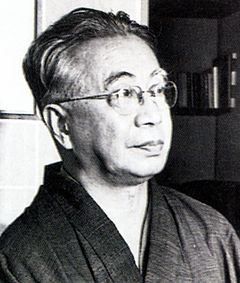- Jirō Osaragi
-
Jirō Osaragi 
Osaragi JirōBorn 4 October 1897
Yokohama, Kanagawa prefecture, JapanDied 30 April 1973 (aged 75)
Kamakura, Kanagawa, JapanOccupation Writer Genres popular historical fiction novels Notable work(s) Kurama Tengu Jirō Osaragi (大佛 次郎 Osaragi Jirō, 4 October 1897 – 30 April 1973) was the pen-name of a popular Japanese writer in Shōwa period Japan, known primarily for his historical fiction novels, which appeared serialized in newspapers and magazines. His real name was Haruhiko Nojiri (野尻 清彦 Nojiri Haruhiko).
Contents
Early life
Osaragi Jirō was born in Yokohama. His older brother Hōei Nojiri, was a noted scholar of English literature and an astronomer.
Osaragi Jirō began writing while still in high school, publishing his first work Ichiko Romance, which described life in the school dormitory. He also became interested in the theatre. He attended Tokyo Imperial University, where he developed a strong sense of resistance to authoritarianism. After graduation, he obtained a posting as a teacher at the Kamakura Higher Girls' School (present-day Kamakura Jogakuin High School), located in Kamakura, Kanagawa prefecture. Because of his language skills, he was recruited by the Foreign Ministry in 1922, and worked there for about a year. However after the Great Kantō Earthquake of 1923, he decided to devote himself full time to writing.
Literary career
In 1924 Osaragi Jirō published his first popular historical novel, Hayabusa no Genji which was serialized in the magazine, Pocket. At this time he was living in Kamakura behind the famous Great Buddha of Kamakura (鎌倉大仏 Kamakura Daibutsu). The Chinese characters for Daibutsu can also be read Osaragi which became the source of his pen-name, Osaragi Jirō. However, his choice of pen name of Osaragi was not mere whimsy: The Osaragi branch of the Hōjō clan descended from Hojo Tokufusa, were prominent warriors in the Kamakura period chronicle Taiheiki. Their estates were located near the Great Buddha.
Osaragi's popular fiction novels with historical settings such as Kurama Tengu (novel) (1924–1959), Teru Hi Kumoru Hi ("Sunny Days Cloudy Days", 1926–1927), and Ako Roshi ("Loyal Retainers of Ako", 1927–1928), were serialized in newspapers and magazines, and gained him a tremendous following. Many were later made into movies and television series, with Kanjūrō Arashi, for instance, making a name for himself playing Kurama Tengu.
However, Osaragi also wrote works of contemporary fiction such as Shiroi Ane ("White Sister") and Kiribue ("Misty Flute"). Kikyō ("Homecoming", 1948) described the author's anger at petty attitudes which surfaced after World War II.
Osaragi was deeply influenced by French literature and culture, and wrote a number non-fiction pieces displaying his deep understanding of controversial events in Europe: Dorefyus jiken ("The Dreyfus Affair"), Buranje Shogun no Higeki ("The Tragedy of General Boulanger"), and Pari Moyu ("Paris is Burning"; a history of Paris Commune). When he died in 1973 at the age of 75, he was still writing Tennō no Seiki ("Century of Emperors"), a historical chronicle based on the spiritual history of the Japanese people.
Private life
Osaragi lived in Kamakura, Kanagawa prefecture from 1921 to his death in 1973. Osaragi was a central figure in Kamakura's literary life, and he also campaigned avidly for the protection of Kamakura's scenic beauty. When housing developers threatened the mountainside behind Kamakura's famous Tsurugaoka Hachiman-gū, he banded together with a number of famous literati and artists (including Hideo Kobayashi, Nagai Tatsuo, Yasunari Kawabata, Riichi Yokomitsu, Itō Shinsui, Kiyokata Kaburagi), residing in Kamakura to oppose the development. This led to the foundation of the Japan National Trust, modeled after the National Trust in Great Britain, and which has been successful in preserving the historical ambience of Kamakura and parts of other cities around Japan.
Osaragi Jirō was a noted cat lover. Friends and neighbors claimed that he fed at least 500 semi-feral cats at his house in Kamakura.
Osaragi also served for two months in the cabinet of Prime Minister Prince Higashikuni Naruhiko as a councillor.
In 1964, he was awarded the Order of Culture by the Japanese government.
Osaragi Jirō's grave is at the temple of Jufuku-ji in Kamakura. Despite Osaragi's long association with Kamakura, due to a dispute over inheritance taxes, his manuscripts and artifacts were donated to the city of Yokohama by his heirs, where they now form the collection of the Osaragi Jirō Commemorative Museum. His house in Kamakura remains in private hands, and is open (occasionally) to the public.
After his death, the Asahi Shimbun established a literary prize, the Osaragi Jiro Prize, which is awarded for the best book published in Japan in the field of social sciences.
Filmography
- Akō Rōshi (赤穂浪士 Akō Rōshi) (1961) - novel for the film
See also
- Japanese literature
- List of Japanese authors
Reading
- Miyaji, Sachiro. Osaragi Jiro shisho: Sei to shi o mitsumete. Nihon Bungeisha (1996). ISBN 453702500X (Japanese)
- Osaragi, Jizo. (tr. Ivan Morris). The Journey. Tuttle Publishing (2000). ISBN 0804832552
- Osaragi, Jizo. (tr. Harold Strass). Homecoming. Tuttle Publishing (1956). ASIN: B000GUA9S2
External links
Categories:- 1897 births
- 1973 deaths
- People from Yokohama
- People from Kanagawa Prefecture
- Japanese writers
- Japanese novelists
- Japanese screenwriters
- University of Tokyo alumni
- Recipients of the Order of Culture
Wikimedia Foundation. 2010.
